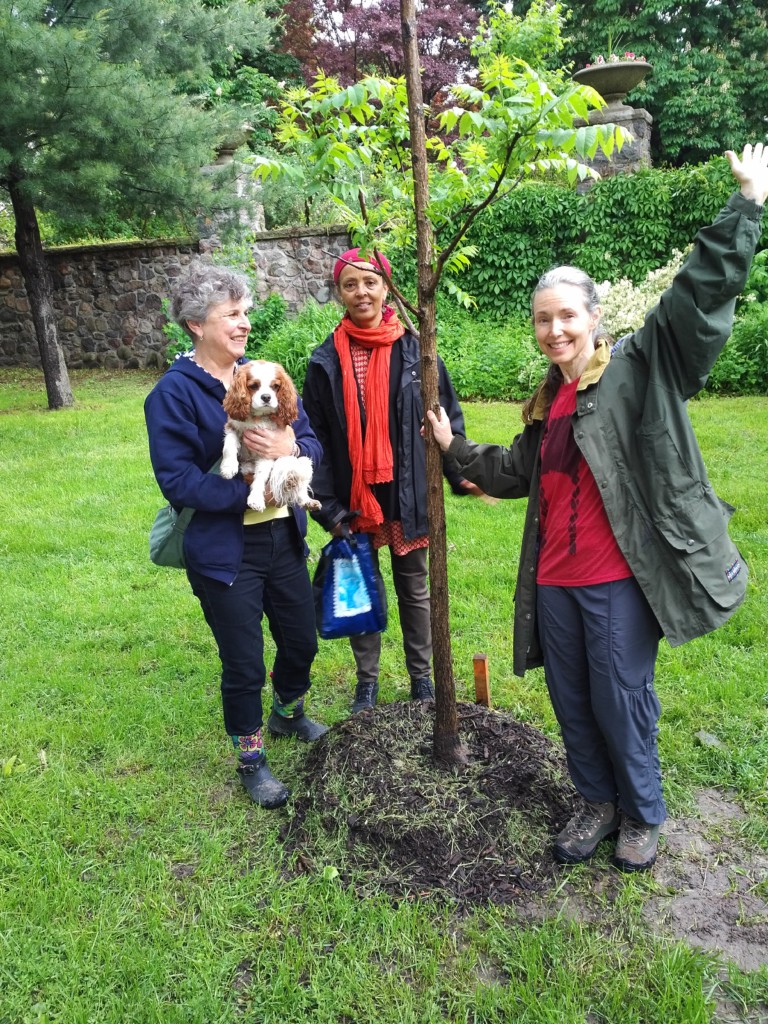Forest Hill Walk Club is a community with heart connecting with nature!
Come join us on a weekly Sunday walk with the Forest Hill Walk Club led by Holistic Nutritionist Cheryl Millett!
Meet other local people who are interested in walking for fitness! Walking is a great way to be active and to create a healthy lifestyle for well-being. Learn about the Forest Hill area while meeting new people. The Forest Hill Walk Club begins each walk with greeting each other, perhaps a share on nutrition and ends with some breathing and stretching movements (weather permitting).
The walk is every Sunday rain or shine all year round. Dress accordingly with the expected weather.

“Walking is a great way to balance working and relaxing. I started the Forest Hill Walk Club to bring awareness to walking, fitness and health. It all started when I left my full-time job at George Weston Ltd/Loblaw Companies Limited where I use to walk every day back and forth to work (20 minutes each way). Living life for well-being…make walking a part of your daily life.” Cheryl Millett, Founder, Walk Leader and Walking Warrior
Cost $2.00 per walk or $20.00 for the calendar year.
Forest Hill Walk Club on Meetup.com Click Here to become a member and have access to walking schedule and information. Free to sign-up.
*Cheryl’s Walking Holidays – Wrapped up in 2023 but what an adventure on the cliffs and in the mountains!
 The Forest Hill Walk Club is more than a walk club:
The Forest Hill Walk Club is more than a walk club:
- In the first two years, the proceeds went towards supporting the Trans Canada Trail. The club purchased one meter of the trail in all Canadian provinces and territories.
- In 2016, monies were raised to purchase a ‘memorial tree’ with the city of Toronto for ‘those who walk with us in spirit’. The black walnut tree can be located in the park at the top of the Baldwin Stairs, just east of Casa Loma. These stairs are walked by the Forest Hill Walk Club.
- Annual anniversary celebrations to celebrate the fitness fun and relationships built due on the walk.
- Special walks, walking to a live concert at the University of Toronto.
- Long lasting friendships and relationships are created.
- Annual hiking holidays to explore walking afar June 2018-2023.
Forest Hill Walk Club Contents
- 10 Benefits of Walking
- Your Walking Routine
- Walking Techniques
- Nutrition
10 Benefits of Walking
Inspired by Tesco Living and other research and articles
Walking is a gentle, low-impact form of fitness that you can do anywhere anytime (almost); it’s easy and free, and suitable for many of all ages and most abilities.
- It strengthens your heart – Regular walking has been shown to reduce your risk of heart disease and stroke. It lowers levels of LDL (bad) cholesterol while increasing levels of HDL (good) cholesterol and keeps blood pressure in check. “Anything that raises your heart rate and gets your blood pumping is a workout for your heart and circulatory system,” says personal trainer Stuart Amory. According to the Stroke Association, walking briskly for up to 30 minutes can help prevent and control the high blood pressure that can cause strokes – reducing your risk by up to 27 per cent.
-
Lowers disease risk
– As well as heart disease, a walking habit can slash your risk of developing type 2 diabetes, asthma and some cancers. A study in the British Medical Journal showed taking more steps every day can help ward off diabetes. According to the charity, Walking For Health, regular exercise such as walking could reduce risk of disease by up to 60 per cent. Those of us who are active have around a 20 per cent lower risk of developing cancer of the colon, breast and womb than those least active.

- It keeps weight in check – Putting one foot in front of the other is one of the easiest ways to manage weight. A person weighing 60 kg burns 75 calories simply by strolling at 2 mph for 30 minutes. Increase that to 3 mph and they’ll burn 99 calories. Speed it up to a fast walk (4 mph) and that’s 150 calories. “Walking also increases muscle mass and tone and the more muscle you have, the faster your metabolism – so the more calories you burn, even at rest,” shares Amory.
- Helps prevent dementia – Dementia affects one in 14 people over age 65 and one in 6 over age 80. We know being active has a protective effect on brain function and regular exercise reduces dementia risk by up to 40 per cent. Also according to Age UK, older people who walk six miles or more per week could avoid brain shrinkage and so preserve memory as the years pass. The Forest Hill Walk Club encourages members to walk every day.
-
Strengthens bones
– “Walking counts as a weight-bearing activity,” says Amory. “It stimulates and strengthens bones, increasing their density – really important, especially for women. Also helps maintain healthy joints so may stave off conditions such as arthritis.”
- Tones your muscles – A good walk can help strengthen and shape your legs, giving great definition to calves, quads, hamstrings and lifting your glutes (buttock muscles) – especially if you add hills to your walk. But if you really pay attention to your posture as you walk, it can tone your abs and whittle your waist, too. Fitness expert Joanna Hall says: “Think about lengthening up through your spine to create space between your earlobes and shoulders.” Let’s not forget your arms – “Your speed when walking comes from your arms,” says Hall. “Hold them at a comfortable level, bent at the elbow, and swing them backwards and forwards as you walk. Swing them faster and you’ll automatically speed up. All this movement tones your arms, shoulders and upper back.” Posture is important and after every walk Cheryl Millett takes the Forest Hill Walk Club through a posture check and certain stretches for the whole body.
- It improves your balance and coordination – When walking you are using the entire body. While walking be mindful, and change up the terrain. Walking on rocks or on the beach will all help strengthen the core. The Forest Hill Walk Club walks on ravine paths and up and down stairs.
-
It boosts your vitamin D levels
– This is the nutrient that you make from the sun’s rays (UVB) and cholesterol. If you’re walking outside in daylight, you’ll be boosting your body’s stores of vitamin D – a nutrient that’s hard to get from food. Vitamin D is a nutrient that plays a big role in everything from bone health to immunity. Practice sun safety but with periods of time where you do not wear any sunscreen you will naturally produce sufficient vitamin D. Some say that our daily washing with harsh soaps can interfere with the production of vitamin D which takes up to 48 hours for production. Others share that lowering your cholesterol may also be interfering. Sublingual Vitamin D Supplementation The Forest Hill Walk Club walks outside all year long to maximum benefits of increasing our vitamin D levels.
- Gives you energy – It might seem like a paradox (and the last thing you might feel like) but a brisk walk is one of the best natural energizers. It boosts circulation and increases oxygen supply to each and every cell in your body, helping you to feel more alert and alive. It wakes up stiff joints and eases muscle tension so you feel less sluggish. Always have a mid-afternoon energy slump at work? Head out for a walk at lunchtime instead of sitting in a café or at your desk and see what a difference it makes.

-
Makes you happy
– The ability of exercise to boost mood is undisputed. Studies have shown regular, moderate-intensity exercise (such as brisk walking) to be as effective as antidepressants in cases of mild to moderate depression. Getting active releases feel-good endorphins into the bloodstream, reducing stress and anxiety. It’s often a social activity – joining a walking group or meeting friends to walk and chat is a great way to banish feelings of isolation and loneliness. A survey by the charity Mind found 83 per cent of people with mental health issues look to exercise to help lift their mood. For greatest benefit, they say, get active outdoors and somewhere green. The Forest Hill Walk Club walks in pairs to encourage healthy socialization.
Your Walk Routine
Dress for the weather – layers are best so as you warm up you can peel them off as needed. Too much clothing may raise the body temperature so that it is uncomfortable. In this case, drink water, unzip your jacket, pull off gloves, etc. Have proper footwear for the weather and terrain…snow will require different treads. Know your terrain and if there is ice, walk very short steps keeping your arms out for balance. Hydrate and nourish depending on the weather and the length of walk. Walk slowly to warm up and cool down. At the end, stretching your muscles is always recommended while you are warm – stretch your hands, wrists, arms, etc.
Walking Techniques
Walking requires a good posture with your head up, shoulders relaxed and back straight, allowing for natural curves. Focus walking on a cloud and not the pounding. The elbow and knee joints can be slightly bent. Picture your body with a golden thread from foot to head pulling you up towards the sky (or the moon if you prefer). Good footwear is required. I have been practicing walking on the front pad of my foot eliminating the shock that occurs when one walks heel to toe. Try things out and see how it feels.
Why run when you can walk:
Researchers analyzed 33,060 runners in the National Runners’ Health Study and 15,045 walkers in the National Walkers’ Health Study. They found that the same energy used for moderate intensity walking and vigorous intensity running resulted in similar reductions in risk for high blood pressure, high cholesterol, diabetes, and possibly coronary heart disease over the study’s six years. Read more about the study highlights.
Nutrition
Along with any fitness plan, we benefit from healthy wholesome food. Start with proper hydration…pure water and select whole foods. Due to the abundance of information out there, consider a program that guides you. For Your Better Health Program
References:
http://www.mayoclinic.org/healthy-lifestyle/fitness/in-depth/walking/art-20046261
***
 Cheryl Millett
Cheryl Millett
Champion For Your Better Health


